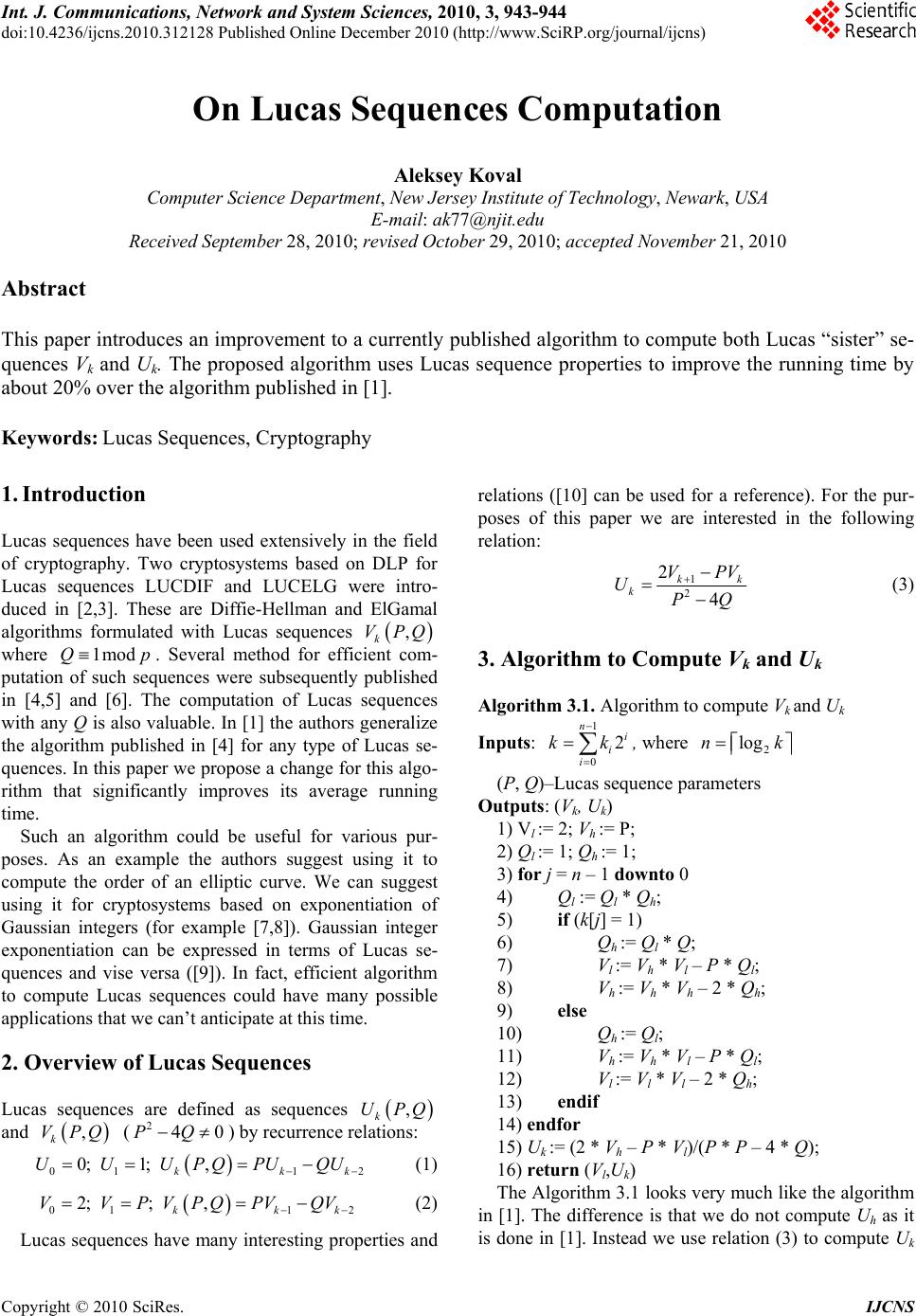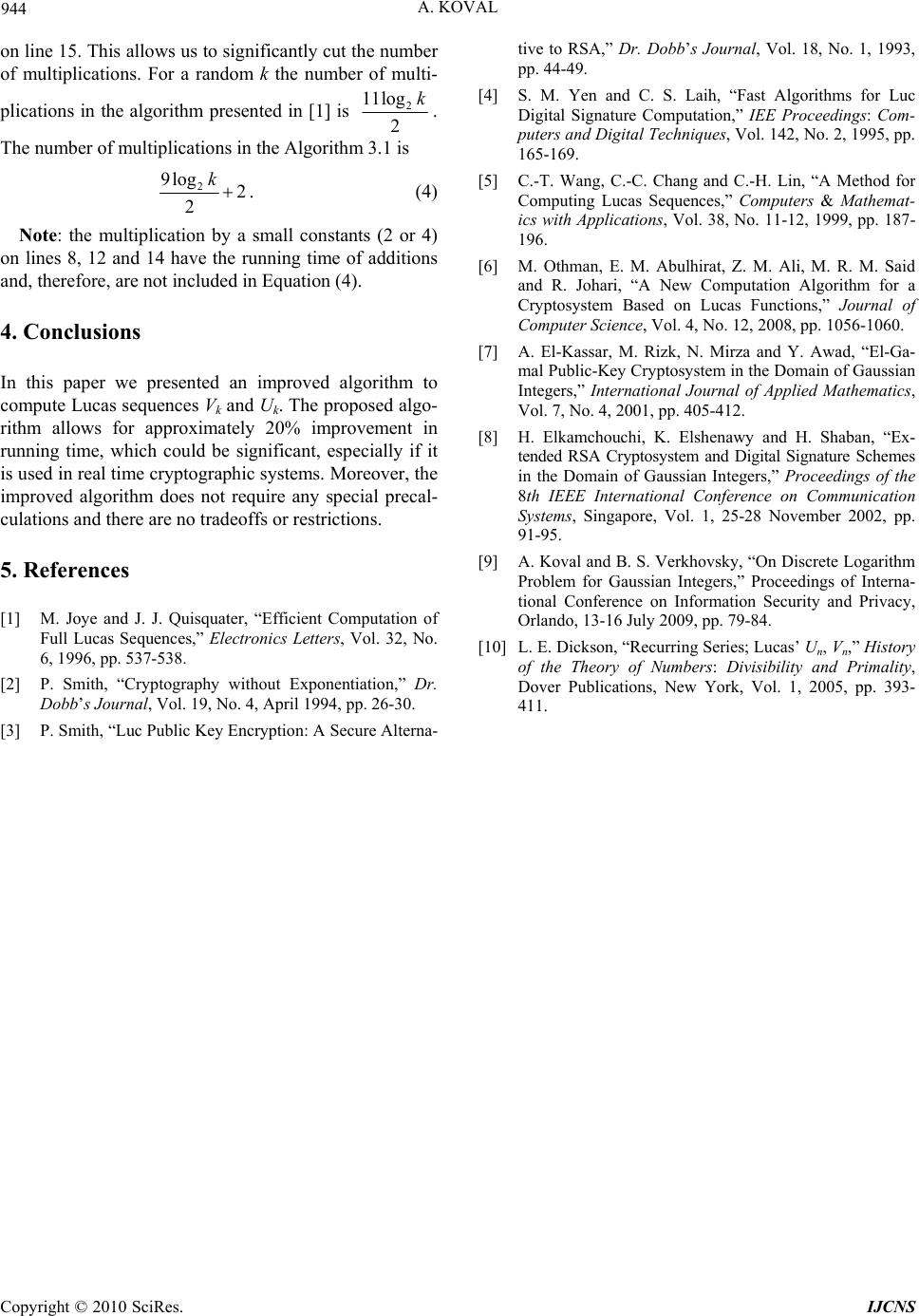Paper Menu >>
Journal Menu >>
 Int. J. Communications, Network and System Sciences, 2010, 3, 943-944 doi:10.4236/ijcns.2010.312128 Published Online December 2010 (http://www.SciRP.org/journal/ijcns) Copyright © 2010 SciRes. IJCNS On Lucas Sequences Computation Aleksey Koval Computer Science Department, New Jersey Institute of Technology, Newark, USA E-mail: ak77@njit.edu Received September 28, 2010; revised October 29, 201 0; accepted November 21, 2010 Abstract This paper introduces an improvement to a currently published algorithm to compute both Lucas “sister” se- quences Vk and Uk. The proposed algorithm uses Lucas sequence properties to improve the running time by about 20% over the algorithm published in [1]. Keywords: Lucas Sequences, Cryptography 1. Introduction Lucas sequences have been used extensively in the field of cryptography. Two cryptosystems based on DLP for Lucas sequences LUCDIF and LUCELG were intro- duced in [2,3]. These are Diffie-Hellman and ElGamal algorithms formulated with Lucas sequences , k VPQ where . Several method for efficient com- putation of such sequences were subsequently published in [4,5] and [6]. The computation of Lucas sequences with any Q is also valuable. In [1] th e authors generalize the algorithm published in [4] for any type of Lucas se- quences. In this paper we propose a change for this algo- rithm that significantly improves its average running time. 1modQp Such an algorithm could be useful for various pur- poses. As an example the authors suggest using it to compute the order of an elliptic curve. We can suggest using it for cryptosystems based on exponentiation of Gaussian integers (for example [7,8]). Gaussian integer exponentiation can be expressed in terms of Lucas se- quences and vise versa ([9]). In fact, efficient algorithm to compute Lucas sequences could have many possible applications that we can’ t anticipate at this time. 2. Overview of Lucas Sequences Lucas sequences are defined as sequences , k UPQ and () by recurrence relations: , k VPQ 24PQ0 2k 2k 01 1 0; 1;, kk UUUPQPUQU (1) 01 1 2;; , kk VVPVPQPVQV (2) Lucas sequences have many interesting properties and relations ([10] can be used for a reference). For the pur- poses of this paper we are interested in the following relation: 1 2 2 4 k k VPV UPQ k (3) 3. Algorithm to Compute Vk and Uk Algorithm 3.1. Algorithm to compute Vk and Uk Inputs: , where 1 0 2 ni i i kk 2 lognk (P, Q)–Lucas sequence parameters Outputs: (Vk, Uk) 1) Vl := 2; Vh := P; 2) Ql := 1; Qh := 1 ; 3) for j = n – 1 downto 0 4) Q l := Ql * Qh; 5) if (k[j] = 1) 6) Qh := Ql * Q; 7) Vl := Vh * Vl – P * Ql; 8) Vh := Vh * Vh – 2 * Qh; 9) else 10) Qh := Ql; 11) Vh := Vh * Vl – P * Ql; 12) Vl := Vl * Vl – 2 * Qh; 13) endif 14) endfor 15) Uk := (2 * Vh – P * Vl)/(P * P – 4 * Q); 16) return (Vl,Uk) The Algorithm 3.1 looks very much like the algorithm in [1]. The difference is that we do not compute Uh as it is done in [1]. Instead we use relation (3) to compute Uk  944 A. KOVAL on line 15. This allows us to significantly cut the nu mber of multiplications. For a random k the number of multi- plications in the algorithm presented in [1] is 2 11log 2 k. The number of multiplications in the Algorithm 3.1 is 2 9log 2 2 k. (4) Note: the multiplication by a small constants (2 or 4) on lines 8, 12 and 14 have the running time of additions and, therefore, are not included in Equ ation (4). 4. Conclusions In this paper we presented an improved algorithm to compute Lucas sequences Vk and Uk. The proposed algo- rithm allows for approximately 20% improvement in running time, which could be significant, especially if it is used in real time cryptographic systems. Moreover, the improved algorithm does not require any special precal- culations and there are no tradeoffs or restrictions. 5. References [1] M. Joye and J. J. Quisquater, “Efficient Computation of Full Lucas Sequences,” Electronics Letters, Vol. 32, No. 6, 1996, pp. 537-538. [2] P. Smith, “Cryptography without Exponentiation,” Dr. Dobb’s Journal, Vol. 19, No. 4, April 1994, pp. 26-30. [3] P. Smith, “Luc Public Key Encryption: A Secure Alterna- tive to RSA,” Dr. Dobb’s Journal, Vol. 18, No. 1, 1993, pp. 44-49. [4] S. M. Yen and C. S. Laih, “Fast Algorithms for Luc Digital Signature Computation,” IEE Proceedings: Com- puters and Digital Techniques, Vol. 142, No. 2, 1995, pp. 165-169. [5] C.-T. Wang, C.-C. Chang and C.-H. Lin, “A Method for Computing Lucas Sequences,” Computers & Mathemat- ics with Applications, Vol. 38, No. 11-12, 1999, pp. 187- 196. [6] M. Othman, E. M. Abulhirat, Z. M. Ali, M. R. M. Said and R. Johari, “A New Computation Algorithm for a Cryptosystem Based on Lucas Functions,” Journal of Computer Science, Vol. 4, No. 12, 2008, pp. 1056-1060. [7] A. El-Kassar, M. Rizk, N. Mirza and Y. Awad, “El-Ga- mal Public-Key Cryptosystem in the Domain of Gaussian Integers,” International Journal of Applied Mathematics, Vol. 7, No. 4, 2001, pp. 405-412. [8] H. Elkamchouchi, K. Elshenawy and H. Shaban, “Ex- tended RSA Cryptosystem and Digital Signature Schemes in the Domain of Gaussian Integers,” Proceedings of the 8th IEEE International Conference on Communication Systems, Singapore, Vol. 1, 25-28 November 2002, pp. 91-95. [9] A. Koval and B. S. Verkhovsky, “On Discrete Logarithm Problem for Gaussian Integers,” Proceedings of Interna- tional Conference on Information Security and Privacy, Orlando, 13-16 July 2009, pp. 79-84. [10] L. E. Dickson, “Recurring Series; Lucas’ Un, Vn,” History of the Theory of Numbers: Divisibility and Primality, Dover Publications, New York, Vol. 1, 2005, pp. 393- 411. Copyright © 2010 SciRes. IJCNS |

